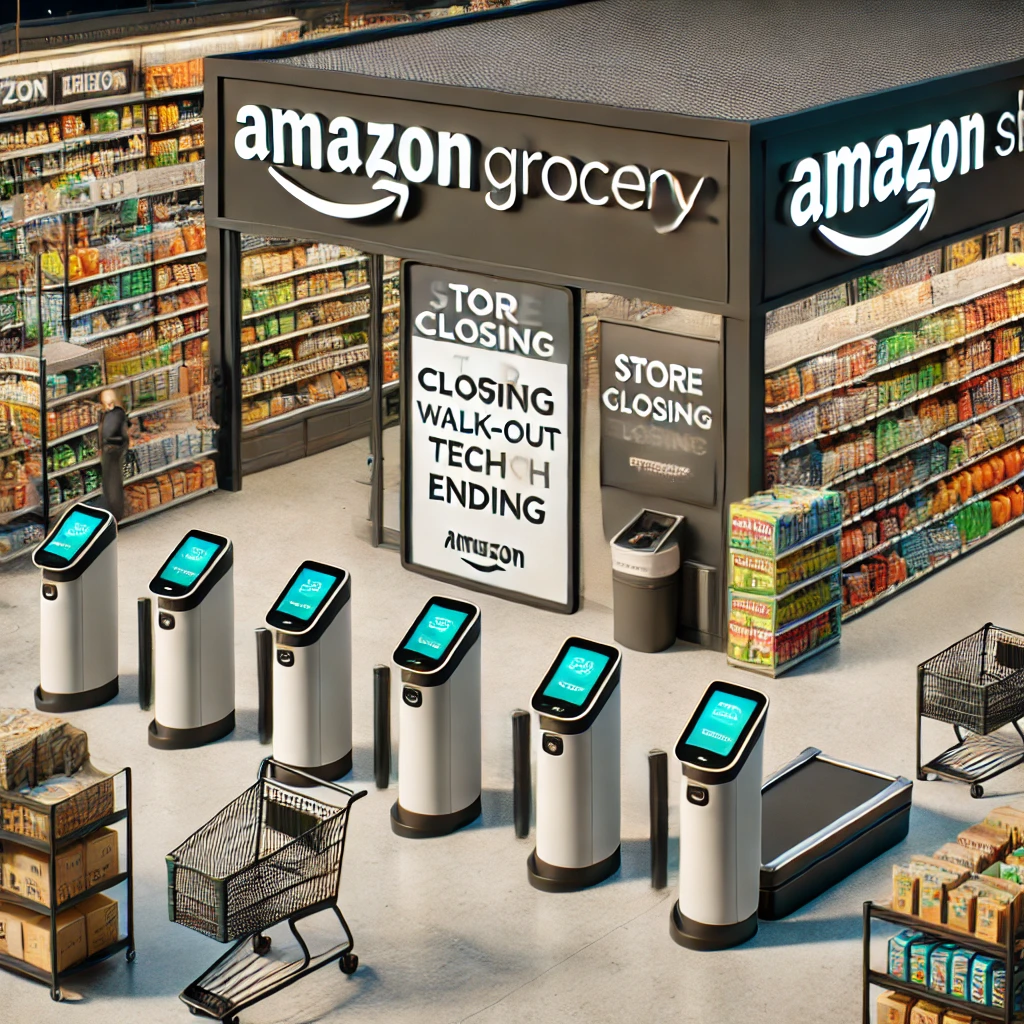Table of Contents
Amazon ditches walk out grocery stores has always been at the forefront of innovation, constantly pushing the boundaries of what’s possible in the retail sector. One of their most ambitious projects was the introduction of walk-out grocery stores, a revolutionary concept that promised to change how we shop. However, recent announcements have revealed that Amazon is ditching this concept. This decision marks a significant shift in their strategy, raising questions about its impact on their business and the broader retail industry.
What is a Amazon
Amazon is a multinational technology company based in the United States, primarily known for its vast e-commerce platform. Founded by Jeff Bezos in 1994, Amazon began as an online bookstore but quickly expanded its offerings to include a wide range of products, from electronics and clothing to groceries and digital services.
What Were Amazon Ditches Walk Out Grocery Stores?
Amazon’s walk-out grocery stores, Amazon Go, were designed to provide a seamless shopping experience. Customers could walk into the store, pick up the items they wanted, and leave without going through a traditional checkout process. The technology behind this concept included computer vision, sensor fusion, and deep learning to automatically detect when products were taken from or returned to the shelves and keep track of them in a virtual cart.
The Evolution of Amazon’s Grocery Ventures
Amazon Go was launched in 2018 with much fanfare and quickly expanded to several locations across the United States. The idea was to offer a quick and convenient shopping experience, especially appealing to urban consumers with busy lifestyles. Initially, the response was positive, with many appreciating the convenience and futuristic feel of the stores. The concept also attracted significant media attention, positioning Amazon as a leader in retail innovation.
Reasons Behind the Decision
So, why did Amazon decide to ditch the walk-out grocery stores? There are several factors at play here:
Financial Performance:
Despite the initial buzz, Amazon Go stores’ financial performance did not meet expectations. The high costs associated with the technology and infrastructure outweighed the revenue generated by the stores.
Consumer Behaviour and Preferences:
While some consumers appreciated the convenience, others were uncomfortable with the level of surveillance and the lack of human interaction. Traditional grocery shopping habits proved to be more resilient than anticipated.
Technological Challenges:
Maintaining and scaling the sophisticated technology required for walk-out stores was more challenging than expected. Issues with accuracy and reliability further complicated the implementation.

Impact on Amazon’s Business Strategy
Amazon’s decision to ditch walk-out grocery stores is more than a shift in one area of their business; it reflects a broader strategic realignment. By stepping back from this concept, Amazon can refocus its resources on other promising regions within the grocery sector, such as its Whole Foods Market acquisition and Amazon Fresh delivery service. This pivot allows Amazon to leverage its logistics and delivery strengths while maintaining a presence in the grocery market.
Market Reactions and Competitor Responses
The retail industry always watches Amazon’s moves closely; this decision was no exception. Competitors have responded quickly, with some continuing to explore their versions of cashier-less stores while others double down on improving traditional shopping experiences. Market analysts have offered varied perspectives, with some seeing this as a prudent move by Amazon to cut losses while others view it as a missed opportunity.
The Role of Technology in Grocery Retail
Technology is crucial in modern grocery retail, but Amazon’s experience with walk-out stores highlights its potential and limitations. While the concept promised unprecedented convenience, the execution proved complex and costly. Future technological trends in grocery retail may focus on incremental improvements that enhance, rather than completely overhaul, the shopping experience.
Consumer Experience and Expectations
Understanding consumer experience and expectations is critical to the success of any retail venture. Amazon’s walk-out stores offered a glimpse into the future of shopping. Still, they also revealed that consumers value certain aspects of the traditional shopping experience, such as human interaction and the tactile experience of selecting products.
Financial Implications for Amazon
Financially, stepping away from walk-out grocery stores allows Amazon to reallocate resources more efficiently. While short-term financial losses may be associated with closing these stores, the long-term benefits of focusing on more profitable ventures outweigh these initial setbacks. This decision could also positively impact Amazon’s stock performance by demonstrating a willingness to pivot and adapt based on market realities.
Lessons Learned from the Walk-Out Store Experiment
Amazon’s foray into walk-out grocery stores offers valuable lessons for the company and the broader retail industry. Key takeaways include the importance of aligning technological innovation with consumer preferences and the need for scalability and cost-effectiveness in new retail concepts. These lessons will undoubtedly inform Amazon’s future ventures and could serve as a blueprint for other companies exploring similar innovations.
Amazon’s Future Plans in Grocery Retail
Despite stepping away from walk-out stores, Amazon remains committed to revolutionizing the grocery sector. Plans include:
It is expanding its Amazon Fresh and Whole Foods Market operations.
We are enhancing delivery services.
Exploring new technologies that improve the shopping experience without the complexities associated with walk-out technology.
Broader Implications for the Retail Industry
Amazon’s decision has broader implications for the retail industry. It signals a potential shift from fully automated stores towards more balanced approaches integrating technology with traditional retail elements. This move could influence other retailers to reassess their strategies and focus on consumer-friendly and financially viable innovations.

Technological Innovations Beyond Walk-Out Stores
Amazon is continually exploring new technological innovations beyond walk-out stores. These include advancements in artificial intelligence, machine learning, and logistics that could further streamline operations and enhance customer experiences. Such innovations have the potential to be game-changers in the retail industry, offering new ways to meet consumer demands.
Customer Feedback and Insights
Customer feedback was crucial in Amazon’s decision to ditch walk-out grocery stores. While many appreciated the convenience, there were significant concerns about privacy and the lack of human interaction. By listening to customer insights, Amazon can better tailor its future offerings to meet consumer needs and preferences.
Conclusion
Amazon’s decision to ditch walk-out grocery stores marks a significant shift in its retail strategy. While the concept was innovative, it faced several challenges that ultimately led to its discontinuation. This move allows Amazon to focus on more promising areas within the grocery sector and demonstrates its commitment to adapting based on market realities. As Amazon continues to innovate, the lessons learned from this experiment will undoubtedly shape its future endeavours in the retail industry.
FAQs
Why did Amazon decide to ditch walk-out grocery stores?
Amazon agreed to do so due to financial performance issues, consumer behaviour and preferences, and technological challenges that made the concept difficult to scale and sustain.
How did consumers react to Amazon’s walk-out stores?
Consumer reactions were mixed. While some appreciated the convenience, others needed to be more comfortable with the level of surveillance and missed the human interaction typical in traditional grocery shopping.
What are Amazon’s financial implications?
Financially, this decision allows Amazon to reallocate resources more efficiently. While short-term losses may exist, focusing on more profitable ventures like Amazon Fresh and Whole Foods Market could provide long-term benefits.
What does this mean for the future of grocery retail?
This decision signals a potential shift in the retail industry towards more balanced approaches integrating technology with traditional elements. It may influence other retailers to reassess their strategies and focus on consumer-friendly innovations.
How will Amazon adapt its grocery retail strategy moving forward?
Amazon plans to expand its Amazon Fresh and Whole Foods Market operations, enhance delivery services, and explore new technologies that improve the shopping experience without the complexities of walk-out technology.

